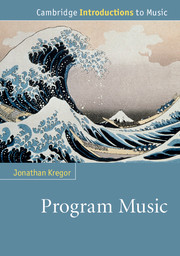Book contents
- Frontmatter
- Contents
- List of Figures
- List of Music examples
- List of Tables
- Acknowledgments
- Note on the text
- Introduction
- Chapter 1 Characters, topics, and the programmatic battlefield
- Chapter 2 Expression, musical painting, and the concert overture
- Chapter 3 Berlioz and Schumann on music and literature
- Chapter 4 Liszt and the symphonic poem
- Chapter 5 The New German School and beyond
- Chapter 6 Excursus: Faust
- Chapter 7 Programmatic paths around the fin de siècle: Mahler and Strauss
- Chapter 8 Programming the nation
- Chapter 9 “Ars Gallica”
- Notes
- Guide to further reading
- Index
Chapter 5 - The New German School and beyond
Published online by Cambridge University Press: 05 January 2015
- Frontmatter
- Contents
- List of Figures
- List of Music examples
- List of Tables
- Acknowledgments
- Note on the text
- Introduction
- Chapter 1 Characters, topics, and the programmatic battlefield
- Chapter 2 Expression, musical painting, and the concert overture
- Chapter 3 Berlioz and Schumann on music and literature
- Chapter 4 Liszt and the symphonic poem
- Chapter 5 The New German School and beyond
- Chapter 6 Excursus: Faust
- Chapter 7 Programmatic paths around the fin de siècle: Mahler and Strauss
- Chapter 8 Programming the nation
- Chapter 9 “Ars Gallica”
- Notes
- Guide to further reading
- Index
Summary
Toward a “Beethoven of the future”: Liszt’s “Dante” Symphony
In early 1839, Franz Liszt began to plan symphonic compositions based on Dante Alighieri’s Divine Comedy and Johann Wolfgang von Goethe’s Faust. By the end of the year, he had written in a public letter to Hector Berlioz that “Dante has found his pictorial expression in Orcagna and Michelangelo, and someday perhaps he will find his musical expression in the Beethoven of the future.” The ensuing decade of intense concertizing meant that he would not be able to realize his plans in earnest until the 1850s, but in the interim he was able to devote considerable energy to a piano piece eventually published as “Après une lecture du Dante – Fantasia quasi Sonata” in Book 2 (“Italy”) of the Années de pèlerinage (1858). During its long gestation, Liszt assigned it various titles: “Fragment dantesque” (1839); “Paralipomènes [Postscript] à la Divina Commedia: Fantaisie Symphonique pour Piano” (c.1848); and “Prolégomènes [Preliminary Discourse] … ” (c.1852).
In good programmatic fashion, the work references, but does not directly cite, two ostensibly incompatible models: Victor Hugo’s poem, “Après une lecture de Dante” (“After Reading Dante”), and Ludwig van Beethoven’s two piano sonatas, op. 27, each a “sonata quasi fantasia.” Hugo distills the thirty-three cantos of Dante’s Hell into almost as many lines of poetry (see Text Box 5.1), and Beethoven – especially in op. 27, no. 1 – infuses sonata structures with spontaneous, improvisational outbursts. Along the same lines as its models, Liszt’s “Dante” Sonata is both poetic and musical gloss, offering “a reading of the Dante” – note the definite article – by way of elaborate thematic transformations and elastic formal structures akin to the Piano Sonata in B minor and Les Préludes.
- Type
- Chapter
- Information
- Program Music , pp. 129 - 160Publisher: Cambridge University PressPrint publication year: 2015

